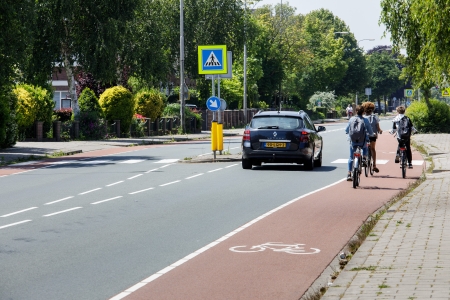Children have gained little experience in road user behaviour. They do not know the traffic rules yet, and still have to learn how to behave in traffic. In addition, safe participation in traffic requires correct perception of speed and distance, and specific motor skills (e.g. road crossing: adapting walking speed to the speed and distance of crossing traffic). Small children are still fully engaged in learning the rules and mastering the skills which will allow them, later in life, to participate in traffic independently. When leaving primary school, their experience is mostly still limited [1]. An overview of what children are roughly able to do at a certain age is presented below. These are guidelines; every child develops skills at its own pace. Differences in gender and character, such as impulse control, may also affect road user behaviour [2].
Aged 0-4
Very young children (up to age 4) do not yet have the motor skills, sensory and cognitive skills required to participate in traffic independently [3]. Their behaviour is unpredictable and, up to age 4, a child is unable to recognise danger. Therefore, up to this age, children should not be allowed to participate in traffic independently [3].
Aged 4-7
Up to age 7, children view the world from an egocentric perspective [1]. They have trouble seeing things from someone else’s point of view. This implies that, when a child sees a car, it automatically assumes that the car/driver also sees him or her. The child is unable to take account of the dangers that are not immediately visible (e.g. when it cannot see other traffic on account of a parked car) [4]. At this age, relatively simple motor skills such as mounting or dismounting a bicycle are still hard to master [5].
Moreover, cause-and-effect does not exist for children up to age 7. They do not understand that their actions may have consequences [1]. Thus, they may be inclined to play ball games in the street, unaware of the consequences of and for oncoming traffic. Children are also less sensitive to visual changes in the size of objects (on the basis of which travel direction and speed of the objects may be estimated). An approaching car is thus less easily discernible to them. Particularly, speeds higher than 30 km/h prevent children, even up to age 11, to see less easily than adults whether a car is approaching [6]. A different study shows that children aged 5 or 6 are less able to scan relevant information in their environment than adults, which might reduce their ability to make safe crossing decisions [7].
Although, at this age, children already quite often find themselves in complex traffic situations, for example when walking or cycling to school, it is important that they are still accompanied by adults.
Aged 7-10
From approximately the age of 7 onwards, children are better able to see things from someone else’s perspective [1]. From that age onwards, children do not base their decisions on the prevailing traffic rules only. They are better able to assess driver intentions on the basis of the driver’s behaviour [8]. Abstract concepts such as time and speed are, however, still hard for them. Children in this age group also have trouble, for example, estimating the speed at which a car is approaching. Complex situations are still very difficult for them and they are often unable to assess such situations. For this age group, also the more complex motor skills, such as keeping one’s balance on a bicycle while indicating direction by hand signals, are still hard [5].
Aged 10-14
From the age of 10, children are able to think in more abstract terms. They are more able to recognise and avoid risks. They are now also more able to understand complex traffic rules. Despite this progress, research shows that, when leaving primary school, cycling children still struggle with certain complex traffic situations [9]. Moreover, in adolescence, children display more hazardous behaviour than adults do. This appears not to be caused, as is often thought, by worse risk perception or overestimation of their own abilities. They even judge their own vulnerability to exceed that of others and generally overestimate well-known risks (such as contracting HIV and lung cancer). Yet, the estimated benefits of certain behaviour, together with their poor impulse control, make them generally take more risks than other age groups [10].
